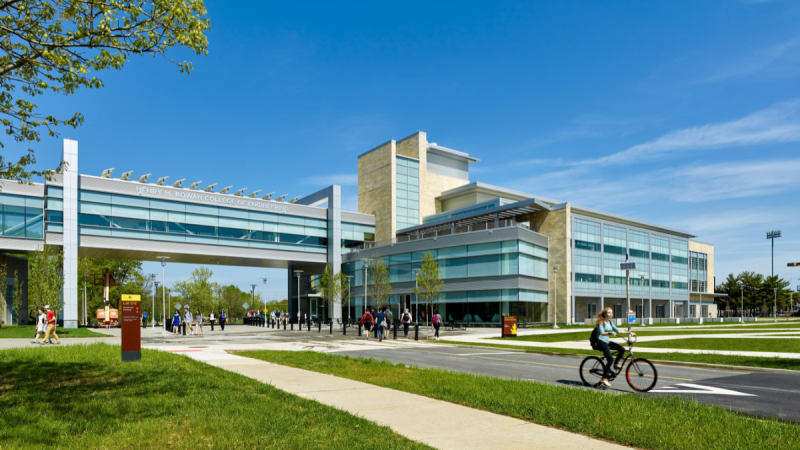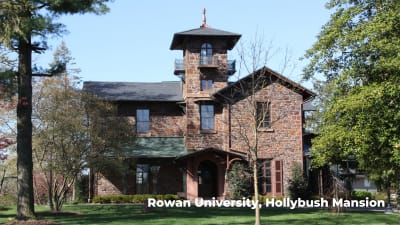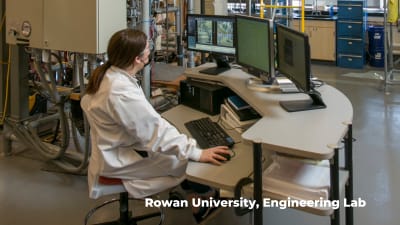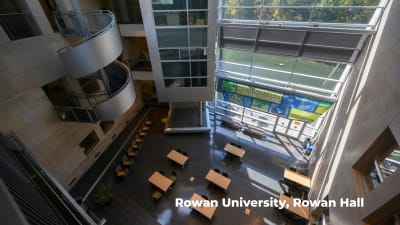Rowan University: How an Engineer’s Unusual Donation Helped Catapult a Public University to Prominence in Academics and Research

Thirty years ago, engineer and industrialist Henry Rowan made what at the time was the largest ever donation to a public university, funding the creation of a brand-new engineering school. Today, the impact of this gift is more pronounced than ever—and not only for engineering students.
A Brief History of Glassboro State College
It’s hard to believe how drastically Rowan University has grown in the three decades that have passed since Henry Rowan made a donation that the school itself has called “transformative.”
In 1992, the year Mr. Rowan made his gift to the institution, Glassboro State College in southern New Jersey was still most widely known as a teacher’s college.
Established in 1923 as Glassboro Normal School (a name which finally changed in 1958), the public college had already grown beyond its humble beginnings by the 1990s, offering majors outside of teaching and education. Glassboro State College was poised to grow, but first, it needed support to reach its full potential.

The institution had also carved out a place in history when it served as the site of the historic Glassboro Summit Conference between President Lyndon Johnson, Soviet Premier Aleksei Kosygin, and other world leaders in 1967, during the Cold War. The two leaders met at the library in Hollybush Mansion on Glassboro State College’s campus, and the meeting has been credited with helping to increase understanding and improve relationships between the U.S. and the Soviet Union.
This was Glassboro State College as it appears before Henry Rowan’s landmark donation: a school with a history of emphasizing hands-on education, in a South Jersey town that was, in the words of U.S. President Johnson, a place of warm friendship and hospitable people... with the goal of leaving this world a little more orderly than we found it.
Decades after this small community captured the world’s attention for its historical significance, its incredible potential would capture Henry Rowan’s attention, too.
A $100 Million Gift That Marked the First of Its Kind
The turning point that not only changed the institution’s name but also put it on the path to becoming a respected research institution well beyond just engineering research—was the donation from Henry M. Rowan and his wife, Betty.
Henry Rowan was an engineer and industrialist who grew up in Ridgewood, New Jersey, and founded his metal-melting furnace business, Inductotherm Group, there in 1953. Mr. Rowan’s innovation and the entrepreneurial venture he started in his basement paid off, and by 1992, he and his wife had amassed a net worth of $300 million, The New York Times reported. Making a major donation to an institution of higher learning was a way to give back, even if getting used to the idea
of making such a massive donation takes at least six months,
as Mr. Rowan said.
The $100 million donation would be paid in annual installments of $10 million over the course of 10 years. By just about any standard, a gift of $100 million is a lot of money. As an endowment made to a public college, however, a donation of this magnitude was unheard of. It nearly doubled the $51.4 million amount of the next-largest donation made by individuals (Rebecca and John Moores) to a public institution of higher learning (the University of Houston). At the time, major individual gifts like the one given by Mr. Rowan were still uncommon, and when large bequests were made, they generally only went to elite private institutions.
Elite private universities were, and still are, used to receiving the lion’s share of donations made to institutions of higher learning. In fact, the eight largest donations made to colleges in 2015—which added up to $1.4 billion and supported just four elite schools—amounted to the same total amount of money donated to the 490 colleges and universities that raised the lowest amounts of donation funding, according to a 2016 article by U.S. News & World Report.
These massive donations by the wealthy to elite private schools with high price tags that already have plenty of resources and that, by and large, educate students from wealthy families represent, as U.S. News & World Report commented, another cycle of income inequality in which the richer get richer and the poorer get poorer.
To put in context the enormous scale of Mr. Rowan’s $100 million gift, the largest donation the institution had ever received prior to the Rowan Gift was $100,000, according to The New York Times. Further, Henry Rowan’s gift was more than the school’s entire operating budget—$93.7 million—for the 1992-1993 school year.
Why Glassboro State?
It’s not unusual for successful alumni to give back to the school that trained them, but Mr. Rowan’s donation wasn’t an instance of alumni giving. Mr. Rowan himself was a graduate of the Massachusetts Institute of Technology, and he deeply respected his alma mater, calling M.I.T. the finest engineering school in the world,
as reported in The New York Times.
Why, then, would he make such a groundbreaking and generous donation to a college he hadn’t even attended, one where there wasn’t even an engineering school for students to follow in his footsteps?
A gift of this magnitude would not have the impact at M.I.T. that it will have at Glassboro,
The New York Times quoted Mr. Rowan as saying.
The reason Henry Rowan’s gift would have a much bigger impact on Glassboro State College than it would have had at M.I.T. is the difference between humble public institutions and elite private universities. M.I.T. was already among the schools with the largest total endowments in the 1990s. The gift would certainly have been accepted and appreciated at Mr. Rowan’s alma mater, where administrators bemoaned being significantly under-endowed
as of 1996 despite already having the sixth-largest total endowment among leading institutions. However, it’s unlikely that this major donation would have produced the kind of tangible legacy at an elite private institution like M.I.T. that it did at Rowan University.
What do elite, wealthy schools do with their endowments? For the most part, research studies show, nothing. Although colleges and universities do use donations they receive to fund operations, research and financial aid, a study by Education Trust found that more than a third of the 67 wealthiest institutions of higher education spent less than 5% of their endowments in 2013, according to MarketWatch. Only 1% of these well-off schools reported spending at least 7% of their endowments in 2013.
Even in 2021, the average rate of annual endowment spending was just 4.5 percent, according to The Washington Post—despite the schools with the 20 highest endowments in the United States seeing market value increases as high as 30, 40, or even 60% over the previous year. The trends show that wealthy schools pinch pennies despite having plenty of resources that could be used to help better fund students’ education and develop new academic and research opportunities.
Realistically, donating $100 million to an already wealthy school would not have made the impact on students or the local community that Mr. Rowan wanted to make. The large donation to an elite school may have looked good in the news and in the school’s bottom line, but it wouldn’t have brought about the kind of revolution in education that the engineering innovator achieved with the gift he gave to then-Glassboro State University.
The gift came with certain stipulations. The school couldn’t use the money for operating expenses or for general capital projects like the building of new infrastructure. The money did specifically provide for certain efforts, the most famous of which is the establishment of the brand-new College of Engineering. Mr. Rowan’s donation would also fund professorships and scholarships, including those for the children of employees at Mr. Rowan’s company Inductotherm. However, as PhillyVoice noted upon the 25th anniversary of the Rowan Gift, the donation allowed for across-the-board development and expansion, benefitting the institution as a whole, not just its future engineering majors.
Out of gratitude—not obligation, as Henry Rowan noted that he’d never asked for the school to bear his name—Glassboro State College changed its name to Rowan College of New Jersey mere months after the donation was officially announced. The institution would hold onto its Rowan name even after it officially attained university status in 1997.
Establishing an Engineering School
Another element that made the Rowan Gift unique is Mr. Rowan’s extensive firsthand involvement in developing the College of Engineering that shares his name. Mr. Rowan didn’t just write a check and walk away. He was deeply involved in the development of the College of Engineering, from inspiring the hands-on, minds-on curriculum of the engineering program to visiting and talking to early students in the engineering school.
Creating a college of engineering from scratch is no simple task. It requires planning a curriculum that would be prepared for full ABET accreditation as soon as the program met eligibility requirements as well as developing the facilities that could support hands-on laboratory and design work in each of the engineering disciplines offered.
Most of all, developing the Henry M. Rowan College of Engineering meant bringing together the people—the founding dean, the founding department heads, faculty and administrators, and the first class(es) of students willing to take a chance on a program that wasn’t yet accredited—who believed wholeheartedly in the vision of Mr. Rowan and the institution’s leadership.

The College of Engineering opened its doors (figuratively, not literally, as the designated engineering building Rowan Hall wouldn’t be finished until 1998) to its first class of around 100 students in 1996 and graduated its first class in 2000. Then and now, what makes the Rowan engineering curriculum unique is the sequence of engineering clinic courses around which the curriculum is built, giving students the opportunity to start gaining hands-on engineering experience from their very first semester of college study.
For the 2021-2022 school year, the total student enrollment of the Henry M. Rowan College of Engineering had grown to 1,801, including 1,551 undergraduate students and 250 graduate students. Other highlights at that time included a student-to-faculty ratio of 22:1, more than 225 partnerships for experiential learning opportunities for students, and rankings within the top 20 nationally among undergraduate engineering programs. The College of Engineering offers numerous opportunities for outreach, competitions, research, and extracurricular involvement. Research is thriving at the College of Engineering, where faculty have been awarded $65 million in research funding since 2017 alone.
The Impact Across Rowan University
Because the Rowan Gift allowed for the funds to be used for the broad purpose of developing the schools, the benefits it offered to the college didn’t end with the creation of the engineering school. The donation facilitated the launch and expansion of a number of different programs, partnerships, and research opportunities, many of which had connections to science and engineering.
In 1992, the institution had just 9,600 students enrolled. By 2017, total student enrollment had jumped to 18,500. As of the 2021-2022 school year, the school boasted 22,640 total students, including 15,147 undergraduate students, 2,640 graduate students, and 1,293 professional and medical students. Further proving the institution’s ability to reach a greater and more diverse population of students are the inclusion of 250 international students hailing from 40 countries and the high percentage of students—36 percent—who come from a background of traditionally underrepresented groups.
It wasn’t purely the size of Rowan University—the number of students enrolled or the number of majors and degree levels offered—that grew under the support of Mr. Rowan’s gift. Opportunities of other kinds, particularly in research, innovation, and entrepreneurship, also expanded. Generally speaking, research wasn’t a meaningful part of Glassboro State College’s reputation or academic activities in the early 1990s, before the Rowan Gift was made. However, the donation allowed for the development of engineering, science, and honors programs and financed endowed professorships, setting the stage for pursuit of the kind of significant research endeavors that would lead to national recognition.
As of 2008, the total amount of external research funding awarded to Rowan University was just $400,000. By 2017, that figure had ballooned to $34 million. Research efforts at Rowan have only continued to grow, as has the funding to support it. For the 2021-2022 school year, the total amount of sponsored research and grant funding had reached $40.5 million.
In 2012, the State of New Jersey designated Rowan University as the second comprehensive research institution in the Garden State. By 2018, research had become so deeply entrenched in the culture and academics of Rowan University that the institution became classified as a Carnegie R2 school, which denotes an institution with high research activity.
As of 2021, Rowan University had been ranked fourth in the nation among the fastest-growing public research universities by The Chronicle of Higher Education two years in a row. It’s hard to imagine that the school would have come so far in its research pursuits in such a short time without the Rowan Gift. The donation made by Mr. Rowan is what precipitated the school’s evolution from an average public state college best known for its history as a teaching school to a comprehensive public research university offering 90 programs of study at the bachelor’s level, 48 at the master’s level, and nine at the doctoral level.
A Chain Reaction of Gift-Giving
Mr. Rowan’s donation made national news and spurred a new wave of collegiate gift-giving, especially major gifts and gifts made to public institutions of higher learning. In fact, over the 20 years following the Rowan Gift, colleges and universities in the United States received more than 120 donations of amounts at or above $100 million, according to South Jersey Magazine.

Although elite private schools still receive a disproportionate amount of donations, Mr. Rowan’s gift disrupted the widely shared notion that public colleges don’t need donations. Henry Rowan himself recalled his initial reluctance to donate to the state.
What changed his mind was learning that the state funding only covers the operating expenses needed to keep the school’s doors open, not to build up an institution that offers more majors, levels of study, and research opportunities.
Henry Rowan didn’t just make a donation to Rowan University—by doing so, he also gave a strong and attention-grabbing endorsement to the institution and its vision for growth. He put his faith in the school, as well as the monetary gift, and his belief in the institution’s potential ignited an interest in other donors, too. Rowan University had received gifts from upwards of 22,000 individual donors by the time the school’s namesake passed away in 2015, according to Philly Voice.
For example, Keith and Shirley Campbell were reportedly inspired by Mr. Rowan’s gift to make their own donation of $1.5 million toward the Rowan University Library, which was subsequently renamed the Campbell Library. Between 1992, when the Rowan Gift was made, and 2017, the institution’s assets rose from just $787,000 to $208 million, Philly Voice reported.
Rowan University wasn’t the only public institution to benefit from Mr. Rowan’s gift. After Henry Rowan’s donation to the development of Glassboro State College and its new engineering school specifically made headlines, the reasons for donating to a public college or university became more widely recognized. As of 2021, the largest donation made to a public university was a $550 million donation to Western Michigan University, according to The Wall Street Journal.
Mr. Rowan, of course, believed strongly in the potential of Rowan University specifically and the South Jersey community. What would you and Glassboro do with $100 million?
Mr. Rowan recalled asking Dr. Philip Tumminia, Vice President for Institutional Advancement at Glassboro State College, in September 1991 as he began contemplating a donation. Seeing what a metamorphosis Mr. Rowan’s gift brought to this one public university inspired other potential donors to ponder what other modest public institutions could accomplish if given the kinds of resources normally gifted only to the elite.
Rowan University, 30 Years Later
At the time the remarkable Rowan Gift was made, the institution had a solid—but nowhere near as distinguished—reputation locally, but outside the region, it was known primarily as the site of the Glassboro Summit Conference some 25 years earlier. Now that it has flourished so spectacularly throughout the region and become nationally recognized among the leading academic rankings and for research, the Rowan name is ubiquitous across South Jersey and widely known beyond.
At Rowan University, students today will find eight distinct colleges:
- College of Education
- College of Humanities & Social Sciences
- College of Performing Arts
- College of Science & Mathematics
- Henry M. Rowan College of Engineering
- Ric Edelman College of Communication & Creative Arts
- Virtua Health College of Medicine & Health Sciences
- William G. Rohrer College of Business
Additionally, Rowan University has nine schools, including both an allopathic and osteopathic medical school, making it the second institution in the United States with both M.D.-granting and D.O.-granting medical schools. The newest addition to the impressive lineup of Rowan University schools is a veterinary school that is scheduled to open in 2025.
The nine schools within Rowan University are:
- Cooper Medical School of Rowan University
- Rowan University School of Osteopathic Medicine (RowanSOM)
- Virtua Health School of Nursing & Health Professions
- Graduate School of Biomedical Sciences
- School of Translational Biomedical Engineering & Sciences
- School of Earth & Environment
- School of Innovation & Entrepreneurship
- School of Professional Studies
- School of Veterinary Medicine
Travel east down Route 322, the U.S. highway that cuts the main campus in half, and you’ll soon reach Rowan Boulevard, a $400 million redevelopment project that represents a collaboration between private investors and the public-sector leaders of the Borough of Glassboro. Go west, instead, and you’ll find the South Jersey Technology Park at Rowan University, where research labs, office space, and a business incubator support both academic research and entrepreneurship innovation. The school also operates a Camden Campus in the city (and county) of Camden, NJ, as well as the Glassboro West Campus and, of course, the Main Glassboro Campus.
With its expansion of program offerings at the master’s and doctoral levels, one might mistakenly believe that Rowan University is only concentrating on developing graduate programs. In fact, Rowan has been actively building partnerships at the community college level across South Jersey for years.
Rowan College of South Jersey is a public community college with two locations, Cumberland (in Vineland, NJ) and Gloucester (in Sewell, NJ). That’s not to be confused with Rowan College at Burlington County, a public community college in Mount Laurel, NJ, which changed its name from Burlington County College in 2015 to reflect a partnership with Rowan University.
Although Mr. Rowan passed away in 2015 at the age of 92, his legacy—not only the gift of his donation but also his own personal involvement in getting the engineering school up and running—shines on today. Rowan engineering faculty who have remained at the school in the decades since the Rowan Gift was made, some of whom are still there today, have fond recollections of meeting Mr. Rowan in person. His spirit of entrepreneurship, of innovation, and particularly of helping people continues to inspire the Rowan Community even now.
For more on the very best institutions of higher learning in the Garden State, check out Universities and Colleges in New Jersey.
Photo Credits: Photos provided by Rowan University, University Relations Department